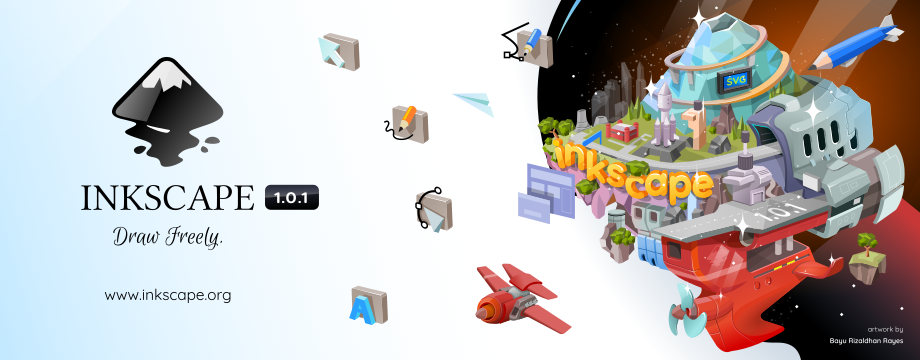
Have passed near four months since Inkscape version 1.0 was released in which a series of improvements were made, of which the improvements to the user interface, a new display mode, support for HiDPI screens, new effects, redesign and translation to Python 3, among other things stand out (if you are interested in knowing the improvements that were introduced in this version, you can check the publication we make about it here on the blog).
Well, now the first corrective version of this version has been released, with Inkscape 1.0.1 being the one that gets to correct errors and deficiencies identified in version 1.0.
What's new in Inkscape version 1.0.1?
In this new corrective version of the software the work was done corresponding to add a dialog box called "Selectors and CSS" in the «Object menu /» Selectors and CSS », which offers an interface to edit CSS styles of the document and provides the ability to select all objects associated with the specified CSS selector.
The new dialog replaces the "Selection Sets" tools, which were discontinued in Inkscape 1.0.
Another functional change is an experimental plugin for PDF export using Scribus, which provides the correct color reproduction suitable for color output along with:
- A color profile to use with the colors in the file
- Being able to map all the colors in the document with the managed color picker in the Fill and Stroke dialog
And also there were changes in the dialog boxes, since fThey were enhanced to change the scaling level, the document properties and scale. Improved 3D box, eraser, gradients, nodes, pencil and tools for adding text.
The fixes highlight the resolution of the problem with the definition of fonts in the package in Snap format.
Of the other changes that have been introduced in this new corrective version:
- AppImage now comes with Python 3.8
- Snap now uses the system font cache and thus finds all installed fonts
- The zoom correction factor is no longer dependent on the display unit, so the correction works correctly for documents that are not in mm
- Zoom no longer causes artifacts when there is a path with an arc segment with a radius of 0 in the drawing
- The keyboard shortcuts for changing angles in the 3D box tool have been adjusted to work as documented, even with the Y axis reversed
- Duplicate circles are now properly closed
- The mass value field is no longer grayed out and can be used
- Simplifying gradient stops selected with Ctrl + L now works
- Keyboard shortcuts with the Alt key to rotate objects also work as documented again with Y axis inversion
- The order of attributes is no longer reversed when saving as SVG, so comparing two SVG files is now easier
- When releasing or undoing a mask, objects will no longer become unselectable and will use their own bounding box
If you want to know more about the changes made in this corrective version, you can go to the following link in which are all the implemented changes.
How to install Inkscape 1.0.1 on Ubuntu and derivatives?
Finally, for those who are interested in being able to install this new version in Ubuntu and other Ubuntu-derived systems, they should open a terminal in the system, this can be done with the key combination "Ctrl + Alt + T".
And in her we are going to type the following command with which we will add the application repository:
sudo add-apt-repository ppa:inkscape.dev/stable sudo apt-get update
Done this to install inkscape, we just have to type the command:
sudo apt-get install inkscape
Another method of installation is with the help of the flatpak packages and the only requirement is to have the support added to the system.
In a terminal we just have to type the following command:
flatpak install flathub org.inkscape.Inkscape
Once the installation is done, you can find the application launcher in your application menu.
Finally another of the methods offered directly by Inkscape developers, is using AppImage file which you can download directly from the app's website.
In the case of this version, you can open a terminal and in it you can download the appimage of this latest version by typing the following command in it:
wget https://inkscape.org/gallery/item/21590/Inkscape-3bc2e81-x86_64.AppImage
Done the download, now you just have to give permissions to the file with the following command:
sudo chmod +x Inkscape-3bc2e81-x86_64.AppImage
Or in the same way by secondary clicking on the file and in properties they click on the box that says run as program.
And that's it, you can run the app image of the application by double-clicking on it or from the terminal with the command:
./Inkscape-3bc2e81-x86_64.AppImage
Great!!! And how can I change the language in the AppImage format ... it won't let me change to Spanish
This article is from masters the explanation. Registered for future articles.